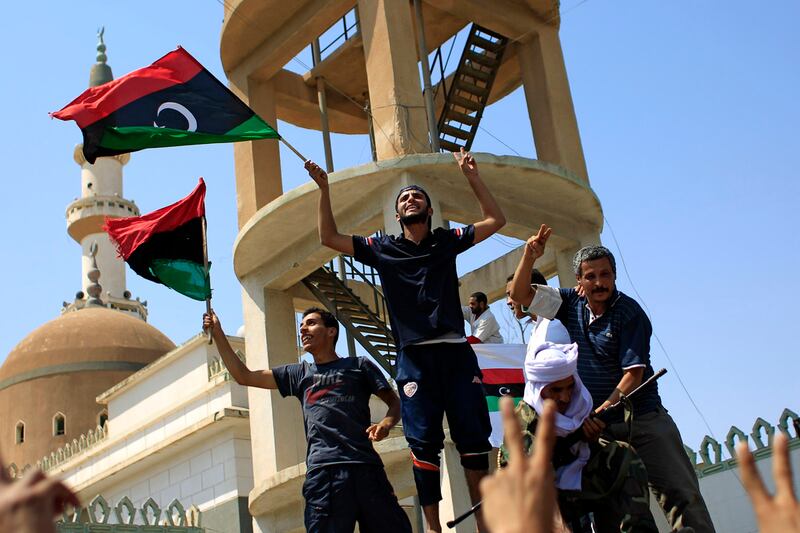Six Months Later, Tripoli
I could go through Tunisia and take the costal road.
I could return to Zintan and drive down to Jebel Nefusa via Gharyan.
Or I could fly from Benghazi to Misrata and take the route the insurgent troops opened up last Saturday, delivering the final blow General Ramadan Zarmuh had come to announce to French President Sarkozy on July 20.
I choose the third option.
In Misrata, I meet again General Zarmuh, who places at my disposal two of these “rolling armored vehicles” I had seen put together in the city’s clandestine workshops, during the siege.
Zlinten, Kaam, Khoms flash by, these former Gaddafist bastions whose names the general had written on a scrap of paper tablecloth in Paris, swearing that, if he received adequate weapons, he would take them, without any opposition, within a few hours.
At first, we have to pass barricades made of turned-over containers and sand that has been packed hard; they are the same as those inside the suffering city that marked the rebels’ re-conquest of Tripoli Street.

Then the route becomes easier, with just a few checkpoints where the flag of Libya’s former monarchy and, often, the colors of the French Republic flutter.
And in less than two hours, we are driving along a palm-lined corniche that runs along a magnificent coast. On the right is a deserted commercial port, then an abandoned military port and, far off, in the bay, ships that seem like phantom vessels. On our left are the skeletons of pharaonic constructions that must have once been the pride of the regime but now stand suspended, only their stripped-down cranes remaining. And then, without warning, we are suddenly in a square, Green Square, the symbol of the regime, the Heidenplatz of the fallen tyrant, the forum where he once convened and harangued his followers.
One is struck, first of all, by the size of this square—smaller than it appears in photos, or in my imagination.
And then, no doubt due to Ramadan, it is surprisingly empty, almost deserted—a few dozen men, no more than that, approaching and shooting celebratory bursts of gunfire into the air.
But either the news of the arrival of foreigners travels fast, or the excitement of the chebabs escorting us, who are also shooting bi-tube rounds in our honor, attracts attention; people start flooding into the square, more and more of them, brandishing their weapons toward the sky and joining in the scene.
I improvise a few words: “A great day…the beauty of the liberation of a city by its own…images of the liberation of Paris…Libya in your hands…no exactions, nor vengeance….”
The young people cry “Allah Akbar”--I reply, “Libya Hora.”
They cheer for France, I salute the Libyan spring.
After about 20 minutes, the noise of the riffs of gunfire preventing us from hearing each other and a few, perhaps, finally recognizing a Frenchman whose demonized image they have seen in a loop on Gaddafi’s broadcasts for months and taking out their cell phones to film him, our Libyan friends suggest we move.
We reach the limits of Bab al Azizia, the guide’s former headquarters, where another form of excitement reigns: it seems they have arrested a sniper.
Take off again towards the south, the area of Abu Salim being, with neighboring Mashrour, the only place we are asked not to enter: fighting is still going on there.
We look for the French Embassy—“the old one or the new?” asks a man of about 50 in a suit. We obviously have no idea, and he guides us through the deserted but liberated streets of the al-Andalus neighborhood to a banal-looking little white building with cubic balconies. It looks like it has been vandalized.
Right near there we encounter a man with a rocket launcher on his shoulder who says he saw us last month at Zintan. He would like to take us to a secret detention area where the Gaddafists in flight had already begun to execute several dozen prisoners.
Further on, in the Qarqash area, on a main road lined with colonial-style apartment houses that remind me of Tangiers’s Italian quarter, they show us the locale of a former training center for women soldiers.
Finally we reach Tajura, this suburb where the elite brigades of the army of Misrata debarked during the night of Saturday to Sunday. Mohamed Chaboun, a young commander who leans on his crutches, describes the operation. With General Zarmuh, he was part of the first unit that, at dawn, tramped through the sands of the outskirts of Tripoli. He had scarcely arrived when he was cut down by a bullet, but, supported by two of his men, he insisted on remaining at the head of his commando as they advanced up to the old city.
It is 7:30 p.m., time to break the fast in these days of Ramadan—dates and goblets of milk are being served on the hoods of the pickup trucks. Should we accept the hospitality of Chaboun, who invites us to spend the night here, by the sea? Or shall we return to Misrata, “my city,” the one that has made me an honorary citizen, one of the chebabs escorting us reminds me, where I am expected. I choose to return to Misrata. But I am so happy to be here, to have come full circle, and to have drawn an epilogue—temporarily—to six months of struggle and hope.






